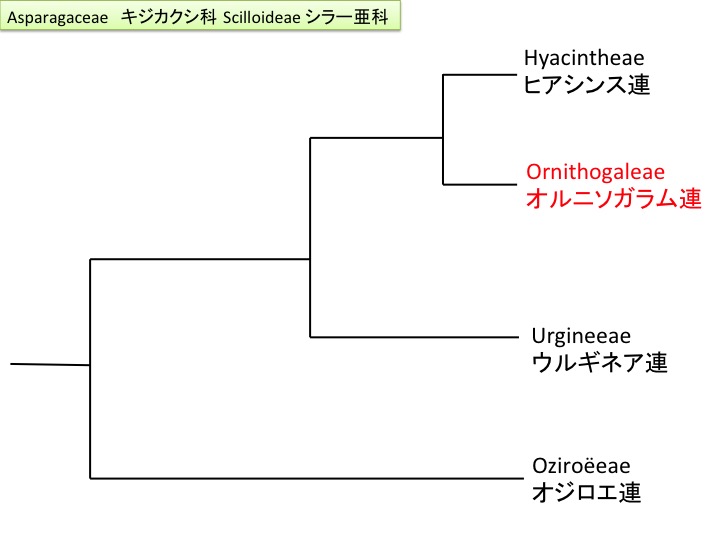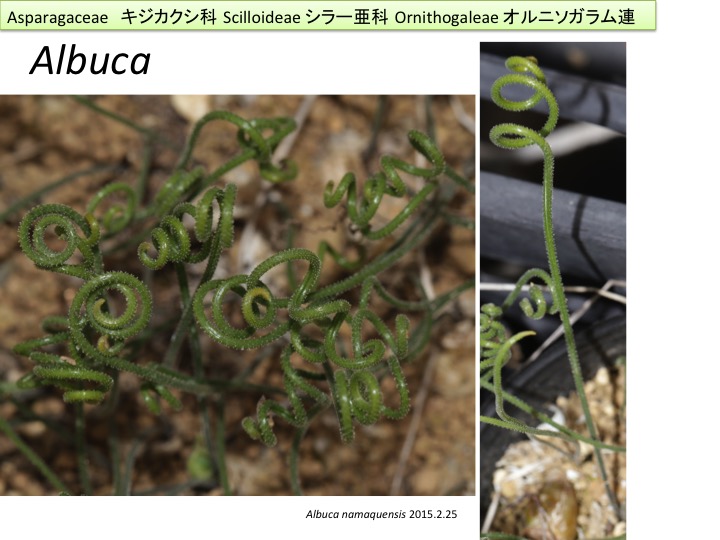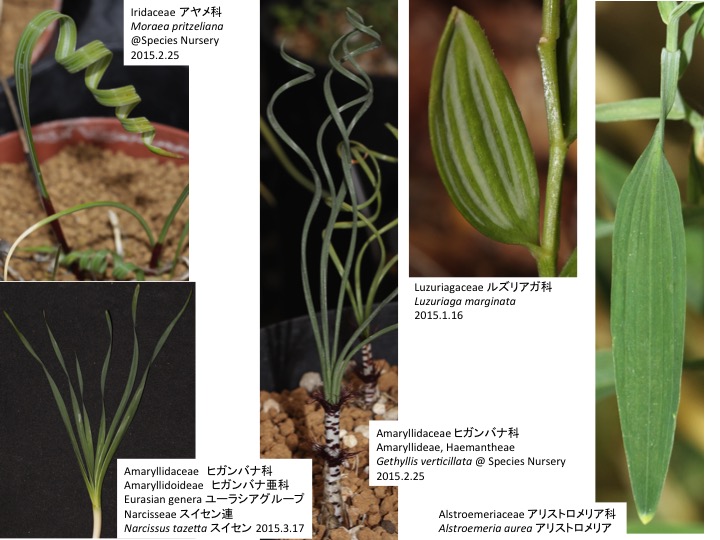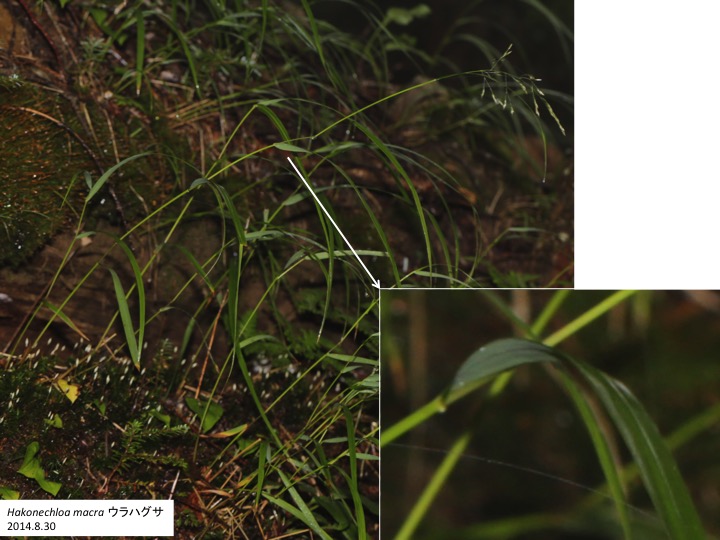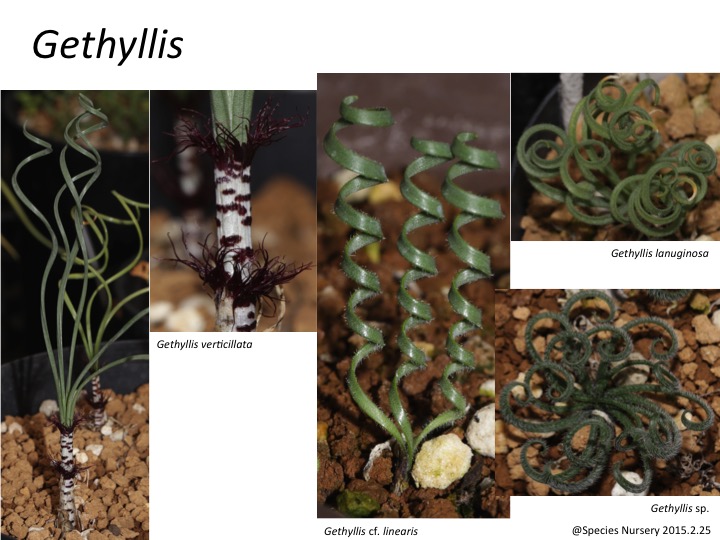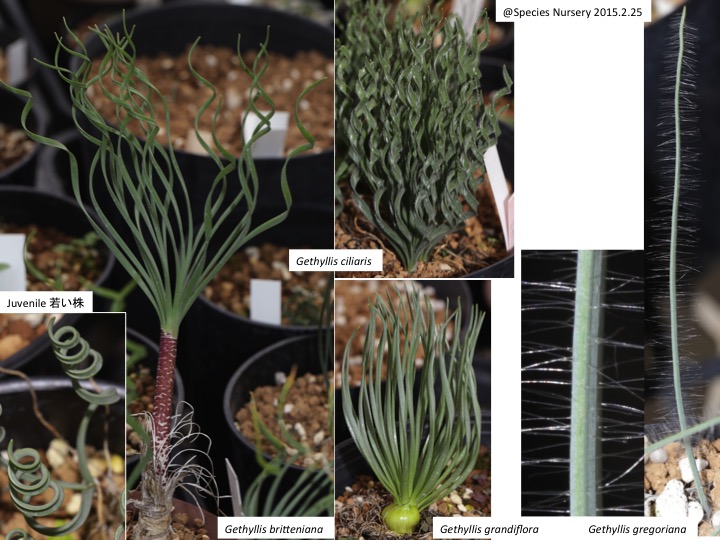Albuca namaquensisの葉は基部側から先端側に見ると反時計回りによじれている。このよじれは、葉の左右の成長の度合いが異なるためだと考えられる。どんな植物も葉は左右非対称である。葉の非対称性には2タイプの機構がある(総説として Chitwood et al. 2012)。一つは葉序に依存した非対称性である。これは、葉原基内で、オーキシン濃度が前の葉の側が次の葉の側よりも高く、それゆえ、前の葉側の葉身が逆側よりも大きくなる。もう一つのタイプは、葉序に依存しない非対称性で、遺伝的に決まっているものである。例えば、アリストロメリアやスイセンの葉は、向かって右側が良く育ち、結果として反時計回りに回転した葉ができる。Albuca namaquensisの場合も、どの個体も反時計回りによじれているので、葉序に依存しないタイプである。どのように分子機構で左右非対称性を産み出し、回旋した葉を形成するのかはわかっていない。
There are two types of mechanisms to cause asymmetry in leaves (summarized in Chitwood et al. 2012). One is phyllotaxis-dependent asymmetry, which is caused by asymmetric distribution of auxin in a leaf primordium. Auxin is more accumulated in a previous leaf primordium side than in a next coming leaf primordium, which results in a larger leaf blade in the former side than the latter side. The other is phyllotaxis–independent asymmetry, which is usually inherent. In Alstroemeria and Narcissus, leaves are resupinate or rotate in a counter-clockwise direction. Leaves of Albuca namaquensis rotates also in a counter-clockwise direction. The molecular mechanisms of phyllotaxis-independent asymmetry is unknown.
Chitwood, D.H. Naylor, D.t., Thammapichai, P., Weeger, A.C.S., Headland, L.R., and Sinha, N.R. 2012. Conflict between intrinsic leaf asymmetry and phyllotaxis in the resupinate leaves of Alstroemeria psittacina. Front. Plant Sci. 3: 1-11.
葉のねじれは単子葉類のアヤメ科(キジカクシ目)、ヒガンバナ科(キジカクシ目)、ルズリアガ科(ユリ目)、アリストロメリア科(ユリ目)、イネ科(イネ目)で見られる。不思議なことに、どの場合も葉は反時計回りにねじれる。ユーカリなどの双子葉類もやはり反時計回りにねじれる。ところが、コバンソウは例外的に右にねじれる(熊澤 1979)。理由は不明である。
ルズリアガ科やアリストロメリア科の種では、葉がねじれが著しく、反転してしまう。しかも、気孔の分布、葉の色、クチクラの量、柵状組織と海綿状組織の分布も通常の葉と較べて逆転する(熊澤 1979)。どうして逆転してしまうのか、そして、反時計回りなのか、理由は不明である。
Leaves are rotated in some species of different monocot families including Iridaceae (Asparagales), Amaryllidaceae (Asparagales), Luzuriagaceae (Liliales), Alstroemeriaceae (Liliales), and Poaceae (Poales). Curiously, leaves always rotate in a counter-clockwise direction except few exceptions including Briza maxima. The reason is unknown.
In species in the Luzuriagaceae and Alstroemeriaceae, Hakonechloa macra, Elymus spp., and so on, leaves are resupinated and characters of leaves including stomata distribution, cuticle deposition, coloration, organization of palisade and spongy cells are reversed between adaxial and abaxial sides.
熊澤正夫 (Kumazawa, M.) 1979 植物器官学 (Plant Organography) 裳華房 (Publisher: Shoka-Bo)
イネ科のウラハグサ属、カモジグサ属、カゼクサ属の葉は半時計周りに表裏が逆転している。コバンソウは例外で、時計回りに逆転している(熊澤 1979)。
Leaves of some Poaceae genera including Hakonechloa macra, Elymus spp., Eragrostis spp. and so on are resupinated in a counter-clockwise direction. Briza maxima with resupinated leaves with a clockwise direction is exceptional.
Gethyllis属はアフリカ南部に約32種が分布する(Meerow and Snijman 1998)。葉は反時計回りに回旋する。
Gethyllis is composed of approximately 32 species distributed in Southern Africa (Meerow and Snijman 1998). Leaves rotate in a counter-clockwise direction.
Meerow, A.W. and Snijman, D.A. 1998. Amaryllidaceae. In Kubitzki, K. The Families and Genera of Vascular Plants. III Flowering Plants Monocotyledons Lilianae (except Orchidaceae). Pp. 83-110

